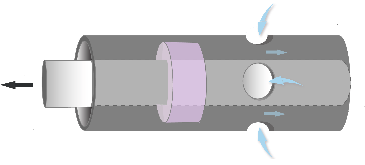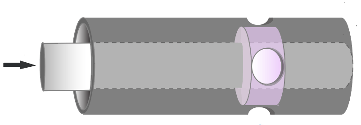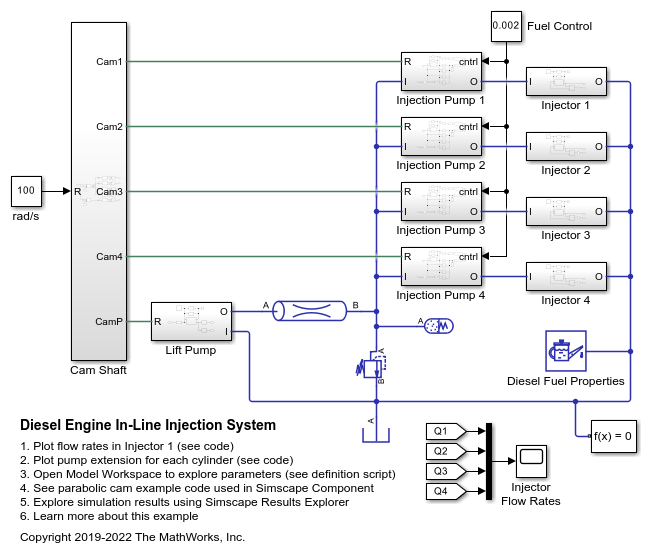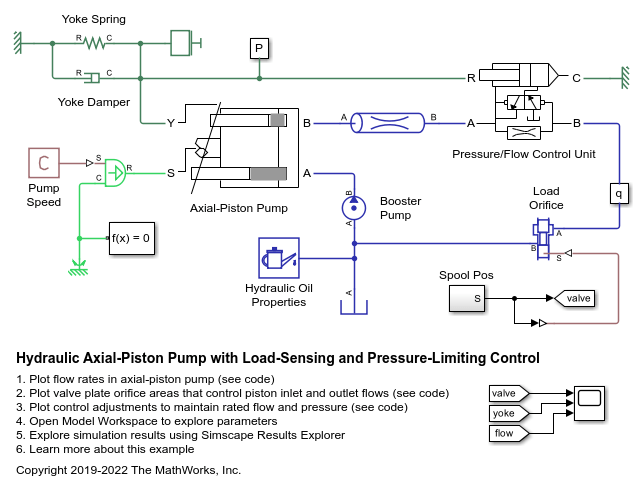Spool Orifice (IL)
Variable-area spool orifice in an isothermal liquid system
Libraries:
Simscape /
Fluids /
Isothermal Liquid /
Valves & Orifices /
Orifices
Description
The Spool Orifice (IL) block models a variable-area orifice between a spool and a sleeve with holes. The sleeve holes can be either a series of round or rectangular holes. The flow rate is based on the total opening area between the sleeve, holes, and spool, which extends or retracts according to the signal received at port S. Multiple Spool Orifice (IL) blocks can be connected for multiple sets of holes along a spool-sleeve pair.
If the spool displacement in your system is supplied by an external source or custom block and you would like the axial flow force to be transmitted to the system, you can use the Spool Orifice Flow Force (IL) block, which applies the same equations for force as the Spool Orifice (IL) block.
Flow Force
The force on the spool is calculated as:
where:
is the mass flow rate at port A.
ρ is the fluid density.
A is the orifice open area, which is determined by the spool position and orifice parameterization.
α is the jet angle, which is calculated from an approximation of the von Mises formula:
where c is the Radial clearance, and h is the orifice opening.
ε is the Orifice orientation, which indicates orifice opening that is associated with a positive or negative signal at S.
Orifice Opening Area
For variable orifices, setting Orifice orientation to
Positive spool displacement opens the orifice
indicates that the orifice opens when the control member extends, while
Negative spool displacement opens the orifice
indicates that the orifice opens when the control member retracts.
The Leakage area, Aleak, is considered a small area open to flow when the orifice is closed, which maintains numerical continuity. Additionally, a nonzero Smoothing factor can provide increased numerical stability when the orifice is in near-closed or near-open position.
Setting Orifice parameterization to Round
holes evenly distributes a user-defined number of holes along
the sleeve perimeter with the equal diameters and centers aligned in the same
plane.


The open area expression is based on a geometric derivation and calculates the area of each hole as a planar circle. If the sleeve is cylindrical, the holes are not planar and this expression is an approximation. The open area is
where:
n0 is the number of holes.
d0 is the diameter of the holes.
Aleak is
θ is the orifice opening area.

θ is set by the control signal at S
where ΔS is the control member travel distance, ε(S - Smin), where Smin is the Control member position at closed orifice.
The maximum open area is:
Setting Orifice parameterization to Rectangular
slot models one rectangular slot in the tube sleeve.

For an orifice with a slot in a rectangular sleeve, the open area is
where w is the orifice width.
The maximum opening distance between the sleeve and case is:
where ΔSmax is the slot orifice Spool travel between closed and open orifice distance.
At the minimum orifice opening area, the leakage area is:
Numerically-Smoothed Displacement
At the extremes of the orifice opening range, you can maintain numerical robustness in your simulation by adjusting the block Smoothing factor. The block applies a smoothing function to every calculated displacement, but primarily influences the simulation at the extremes of this range.
If the Smoothing factor
parameter is nonzero, the block smoothly saturates the orifice opening between
0 and ΔSmax where
ΔSmax is the:
Value of the Diameter of round holes parameter, when Orifice parameterization is set to
Round holes.Value of the Spool travel between closed and open orifice parameter, when Orifice parameterization is set to
Rectangular slot.
For more information, see Numerical Smoothing.
The Mass Flow Rate Equation
The flow through a spool orifice is calculated by the pressure-flow rate equation:
where:
Cd is the Discharge coefficient.
A is the Cross-sectional area at ports A and B.
is the average fluid density.
Aorifice, is the orifice open area, unless:
The opening is larger than or equal to the area at the Spool travel between closed and open orifice distance. The orifice area is then Amax.
The orifice opening is less than or equal to the minimum opening distance. The orifice area is then Aleak.
The critical pressure difference, Δpcrit, is the pressure differential associated with the Critical Reynolds number, Recrit, which is the point of transition between laminar and turbulent flow in the fluid:
Pressure loss describes the reduction of pressure in the orifice due to a decrease in area. PRloss is calculated as:
Pressure recovery describes the positive pressure change in the orifice due to an increase in area. If you do not want to capture this increase in pressure, clear the Pressure recovery check box. In this case, PRloss is 1.
Assumptions and Limitations
The transient effects are negligible.
The jet angle approximation is based on the Richard von Mises equation.
The jet angle variation with the orifice opening is identical for the rectangular slot and the round holes orifices.
Examples
Ports
Conserving
Input
Output
Parameters
Extended Capabilities
Version History
Introduced in R2020a


